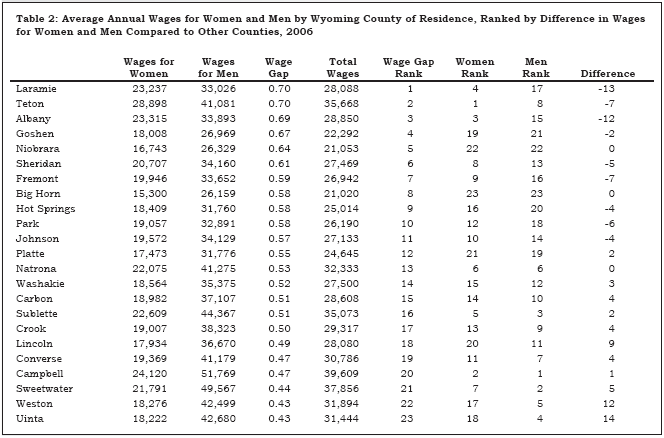Examining the Wage Gap in Wyoming’s Counties
In 2006 in Wyoming, year-round, full-time working women earned 66 cents for every dollar earned by year-round, full-time working men. Using a different metric that compares total average annual wages for men and women, regardless of hours or weeks worked during the year or industry of employment, Wyoming women were paid 55 cents for every dollar their male counterparts were paid in 2006 (Jones, 2007). Regardless of the measurement used, the wage gap is higher in Wyoming than in other areas of the country.
Governor Dave Freudenthal recently declared April 22 to be Equal Pay Day in Wyoming (Wyoming Business Report, 2008), thereby recognizing the wage gap between working men and women around the nation and the state. According to national statistics, women in the United States were paid an average of 81 cents for every dollar their male counterparts were paid in 2006 (U.S. Bureau of Labor Statistics, 2007). In Wyoming, year-round, full-time working women earned 66 cents for every dollar earned by year-round, full-time working men. Using a different metric that compares total average annual wages for men and women, regardless of hours or weeks worked during the year or industry of employment, Wyoming women were paid 55 cents for every dollar their male counterparts were paid in 2006 (Jones, 2007).
Regardless of the measurement used, the wage gap is higher in Wyoming than in other areas of the country. The reasons are numerous. One factor could be that men in Wyoming, especially those working in an expansion-related industry, receive comparatively high pay while women in Wyoming receive comparatively low or average pay. This idea was first introduced in 2007 (Jones) when median weekly earnings for men and women were ranked by state. It was found that the states on the edges of the wage disparity distribution are those with the largest difference in men’s wages ranking versus women’s wages ranking. Those with the largest wage disparity (Wyoming, Wisconsin, Utah, and Idaho) had wages for men ranked considerably higher than wages for women. Alternatively, the states with the smallest wage disparity (with one exception) are the states with the largest difference in ranking, where the women’s earnings are ranked higher than the men’s.
To further explore the idea that wage disparity in Wyoming is driven more by high wages for men than by wages for women, we computed average annual wages for men and women at the county level. Two sets of tables were created: one for county of employment and one for county of residence. The tables are available at http://doe.state.wy.us/LMI/earnings/toc.htm.
To do the analysis we ranked all of the counties by average annual earnings for men (1 is the highest). We then ranked the counties again by average annual earnings for women and then again by women’s earnings as a percentage of men’s (see Table 1 and Table 2).
The findings were similar to those using states as comparators. The counties with the largest wage gap (either by place of work or place of residence) were the counties where men’s wages ranked considerably higher compared to other counties than did women’s wages. The counties with the smallest wage gap were those where women’s wages ranked considerably higher compared to other counties than did men’s wages. Laramie and Teton counties had the lowest wage disparities in both the county of residence and county of employment analyses. Uinta and Weston counties had the largest wage disparities when considering county of residence while Sweetwater and Lincoln counties had the largest disparities when considering county of employment.
The county-level analysis supports the previous state-level findings that high wage disparity is a function of the difference in ranking between average male and female earnings.
ReferencesJones, S.D. (2007, April). Demographic effects of Wyoming’s energy-related expansion. Wyoming Labor Force Trends, 44(4), Retrieved April 23, 2008, from http://www.doe.state.wy.us/LMI/0407/a1.htm
U.S. Bureau of Labor Statistics. (2007, September). Women in the labor force: A databook. Retrieved April 23, 2008, from http://www.bls.gov/cps/wlf-databook-2007.pdf
Wyoming Business Report. (2008, April 22). Today is equal pay day. Retrieved April 23, 2008, from http://www.wyomingbusinessreport.com/article.asp?id=92790
Return to text

Return to text

Last modified on
by April Szuch.
